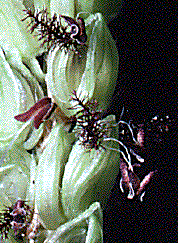



Glumiflorae: More on MorphologyOne feature that has contributed to the success of the Glumiflorae is their ability to spread vegetatively by creeping stems. Unlike trees and most herbs, the Glumiflorae have a primary stem that grows along the surface of the ground, or even underground as in bamboo. Branches or leaves are then sent upwards to gather light for photosynthesis. It is this “sideways” growth of the stem that keeps grass growing even after being mowed. Leaves are usually attached to the stem in two rows, running along each side, except in many sedges. The triangular arrangement of the leaves in sedges is actually a very good character for recognizing them. This has given rise to the saying:
But grasses have nodes from their tips to the ground. The “edges” are there because of the way the leaves meet each other along their edges, while the “round” rushes usually have one leaf sheathing the stem. “Nodes” are swollen regions of the stem, where leaves are attached, and can be felt by running your hand along the stem. Of course this saying assumes that you can recognize cattails, bur-reeds, and other Glumiflorae; it is the rushes, sedges, and grasses that are most easily confused. In the Glumiflorae, the leaf bases are wrapped tightly around the stem, often obscuring the stem completely as the leaves overlap. There may also be silica in the leaf epidermis making it feel rough, probably an adaptation to deter herbivores. If you ever have the chance to look closely at a corn stalk, you can see all these features. Members of the Glumiflorae are anemophilous, or “wind-loving.” This term refers to the way in which these plants are pollinated. Rather than relying on insects or birds to carry their pollen, graminoids make use of the wind. This reliance on wind pollination is probably responsible for the loss of petals and sepals in members of this group. That’s right! Grasses, rushes, and sedges all produce flowers that must be pollinated for sexual reproduction to occur. If you are surprised by this, don’t feel bad, most people have never gotten a close enough look at these plants to see their flowers, and besides, they don’t have showy petals. In fact, many species have no petals at all; their flowers are simply anthers and pistil. In the picture at right, you can see a closeup of the flowers of Paspalum, a grass. The fuzzy black hairs are the tips of the pistil (the stigma); these hairs are sticky, and help the flowers to capture the pollen. Cornsilk is also a collection of stigmata, and each thread of the cornsilk connects to a flower with an ovule. |



|
